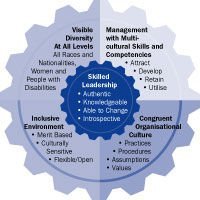In a rapidly changing business environment decision-takers in large organisations are recognising that, in order for their company to succeed, they need to develop a human resources strategy that is an integral part of their corporate strategy.
For example, the company wants the best and most talented people within the busine Fss, those with the capability to engage in business with different customers in different markets around the world. It also wants the organisation to bring people from different cultures and backgrounds together who are capable of developing new solutions to business problems and issues.
Equal opportunities exist in the workplace when individuals have identical rights and responsibilities regardless of gender, racial group, age, physical characteristics, sexual orientation or other characteristics. In a regulated society, all business organisations must seek as a minimum, to meet equal opportunity legislation within a statutory framework. However, in recent years progressive organisations have adopted a ‘managing diversity’ approach rather than simply an equal opportunities stance.

Equal opportunities are based upon the notion that when people are in the same situation they should be treated in the same way. Managing diversity sees gender, ethnic background and other forms of differentiation as relevant to the business success of the organisation. It accepts that if organisations are to move forward and develop opportunities better than other organisations, they need the best people. These people are only available if they positively draw upon a much wider range of talent.
According to business experts, winning companies ‘search for and arrive at the best combination of management principles to mix the cultural beliefs and backgrounds of their employees.’ This case study focuses upon the Diversity Initiative developed by Cummins. In doing so, it shows how the initiative has enabled the company to create an inclusive culture beyond equal opportunities legislation.

Cummins is one of the world’s leading manufacturers of high performance, low emission diesel engines and power generation sets. The company also includes component technology leaders such as Hoslet turbochargers, Newage alternators, Fleetguard filtration systems and Nelson exhaust products.
Operating in business-to-business markets, Cummins reported worldwide sales of $6.6 billion and employed 28,500 people in 1999. The company has been established in the UK for almost 50 years and operates 6 highly productive manufacturing plants located across the country.
As a global company, people are viewed as the key to the performance of the company. There is great emphasis upon having a diverse, achievement-orientated workforce and this is viewed as essential to the process of continuously improving performance. A diverse workforce also helps to reflect the increasingly diverse international customer base of the company.
In the past, large engineering businesses were perceived as being predominantly white, male-dominated organisations. In recent years this notion has disappeared as the labour market has changed.

Organisations are now much more sensitive to where and how they can compete. Ever-rising customer expectations, increased competition and globalisation make it more important than ever organisations employ not just the right kind of people but also the best. This is something that can only be done through an inclusive strategy that focuses upon all types of people in the community as a potential source of employees.
In a team-based environment, the effectiveness of a team depends upon the mix of the abilities of its members. Research shows that successful teams require a range of appropriate skills and qualities, and that these are further enhanced when members of the team include both genders and represent widespread cultures and values.
To recruit the best people and develop the company competitively, it was necessary for Cummins to move beyond its former approach. This approach focused on local communities and the equal opportunities legislation and tended to be exclusive. A much wider all-embracing inclusive approach was needed.
The Diversity Initiative aims to:
- have access to people with the best talents available
- develop an employment profile that reflected and matched the different customer needs satisfied by the organisation around the world
- build an organisation that demonstrates visible diversity at different levels. Employing people from different ethnic origins and women – including appointments at senior levels of management
- create an organisation in a harassment free working environment, commited to removing any form of bias or prejudice against gender, age, religion or ethnic origin
- bring together people from many different cultures and backgrounds. They could then draw on many different perspectives which enable them to achieve more effective solutions and work with higher levels of creativity.
At the heart of the diversity process is the Diversity Chart. Skilled leadership is the centrepiece that links the four other vital elements within the business, thus creating:
- visible diversity at all levels of the business, including ethnic groups, nationalities, women, people with disabilities, age groups and religion
- the development of a flexible and open inclusive environment based upon merit
- managers with multi-cultural skills and competences that attract, develop, utilise and retain the best people
- an organisational culture that absorbs all of this in through its practices, procedures, assumptions and values.

Leadership teams
Within each business operation, the goal is to create teams that include at least one international person, a woman and a person from an ethnic minority background. These teams have many responsibilities such as recruiting/mentoring and developing programmes for employees from diverse backgrounds.
Local diversity councils
Again, each part of the organisation has an active diversity council that meets regularly and develops and helps to implement diversity plans. Each diversity council develops its own ‘business case’ for diversity within its area. Councils represent employee’s issues and concerns on diversity matters and develop improvement ideas for inclusion in the organisation diversity plans.
Employee focus groups
Either a formal or informal process of discussion takes place with representatives on a regular basis.
Diversity training
Leaders from all over the organisation are trained in diversity which is then cascaded down to all employees.
Joe Mukwala is the Cummins Regional Manager for Southern Africa. He believes that a key part of the Diversity programme is its emphasis upon education and training. In fact, without this Joe feels that the process of diversity would simply be tokenism. For example, members of the disadvantaged communities, particularly in Southern Africa, who are not given access to education and training would only have limited opportunities despite being in employment.
Prior to joining Cummins, Joe was an active member of the ANC. When he joined the company as an apprentice in 1989, he was invited to the UK to train and develop his educational background. Studying at both college and university, alongside work, provided a fundamental grounding for senior management within the group and included obtaining an MSc. in Mechanical Engineering.

As a result both Cummins and its practices have become well-known within Southern Africa, not just for its recruitment and development programme, but also for its ability to access and gain the most from the talents of its people.

During her first year, Julie trained in several departments before being assigned to the bearings section, with support provided to ensure she could take on a challenging role while maintaining her family commitments. The diversity programme is aimed at attracting new recruits such as Julie to the company and providing a more flexible working environment to help them reach their full potential.
The Diversity Initiative has ensured that, in seeking a wider and more talented selection of recruits, Cummins has focused broadly upon demographic groups.
Recruitment has taken place using non-traditional sources such as a range of external agencies as well as the Internet. The process has helped to break down the stereotypical view of Cummins as a ‘traditional’ manufacturing organisation.
One of the key benefits of this form of diversity is that the experiences and backgrounds of the recruits is very diverse and covers many experiences. This means that the process creates a ‘constructive tension’ encouraging employees working together to think of different, and sometimes new and better, solutions to both technical and business problems.
As a result, this process improves both the capability of the company and its competitive position within key markets.
A key element in implementing the Diversity Initiative has been the year-by-year Diversity Plan. A plan is an important element within any initiative as it provides a guide as to what should be happening and how the initiative should be implemented. For example, the 2000 Diversity Plan set specific objectives across a range of key areas such as:
Visible Diversity
- give representation on senior staff groups
- establish recruitment milestones for each part of the organisation
- define which elements of diversity are being targeted
Management with Multi-Cultural Skills and Competencies
- promote cross-cultural development experiences appropriate for leaders within the organisation
Skilled Leadership
- ensure that leaders have undertaken the diversity training
- introduce pilot mentoring programme
Most Suitable Organisational Culture
- introduce diversity training for all employees
- set benchmarks
- gain recognition for the programme
Inclusive Environment
- establish Diversity Councils
- improve the induction process.
Driven internally, the Diversity Initiative is being audited using internal assessment processes.

The scheme has significantly changed Cummins’s methods of recruitment. The use of the internet has helped to open up more avenues for recruiting diversity. This approach has changed people’s perception of Cummins, as well as helping to dispel stereotyped views of the engineering industry.
Decision-takers have come to realise that diversity is not just a social policy, but more a long-term opportunity to improve an organistion’s competitive advantage.
